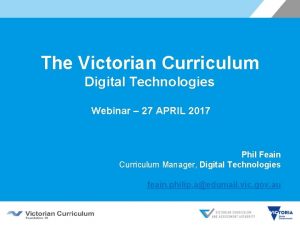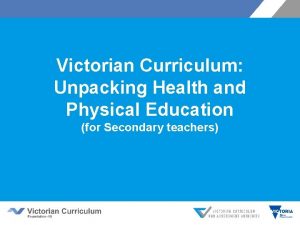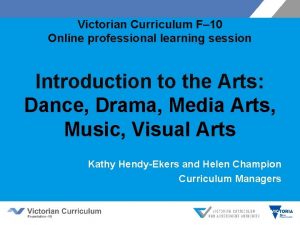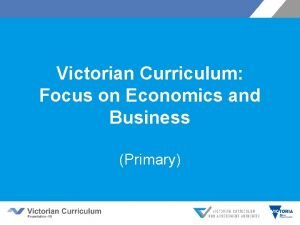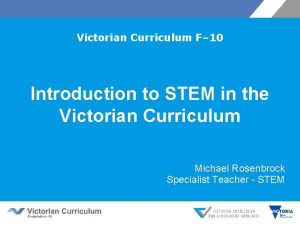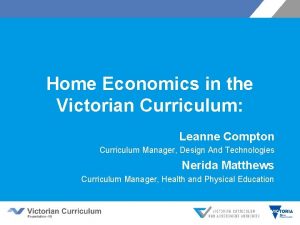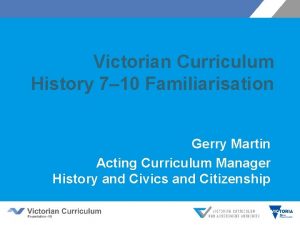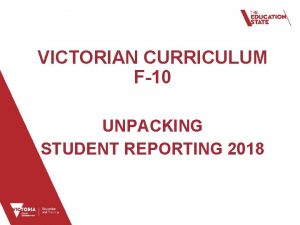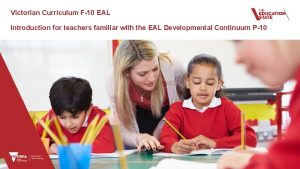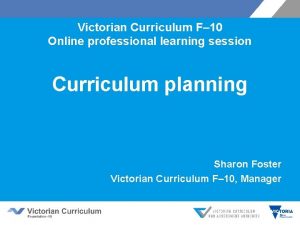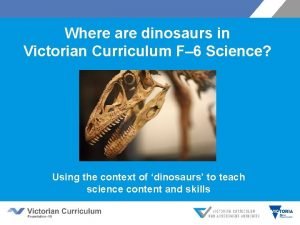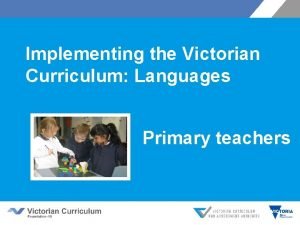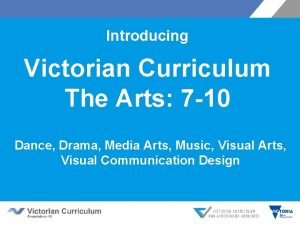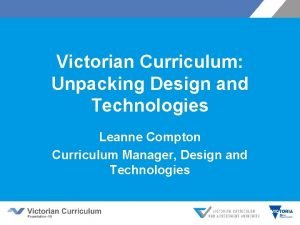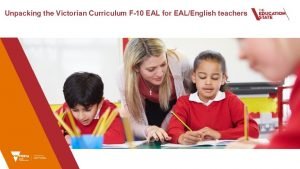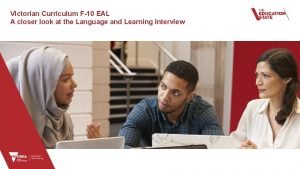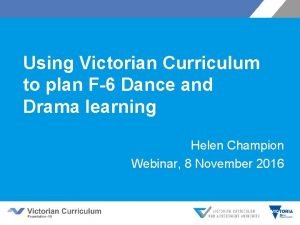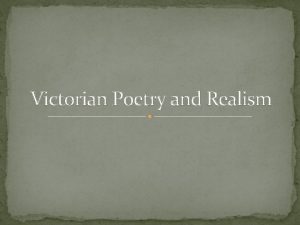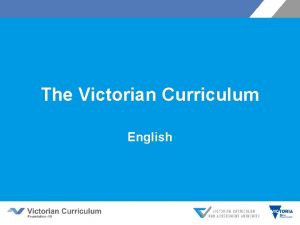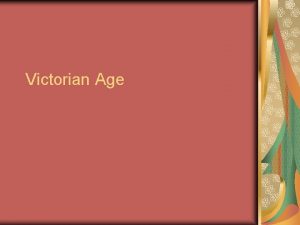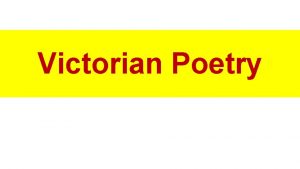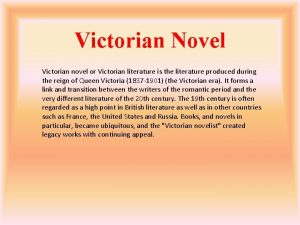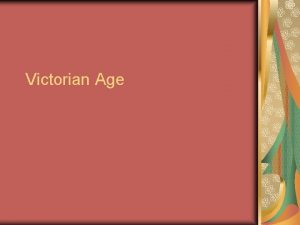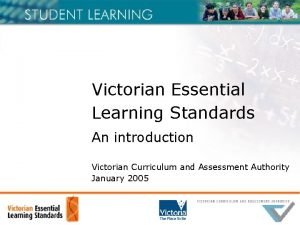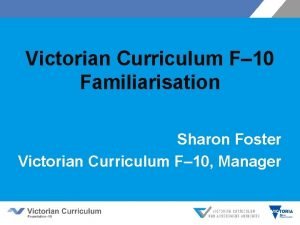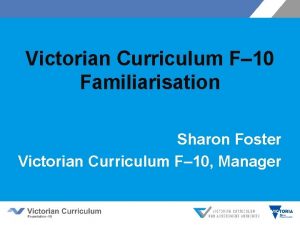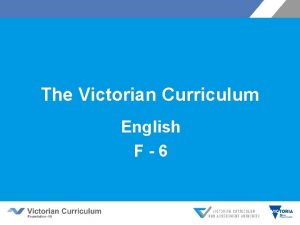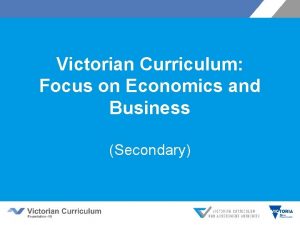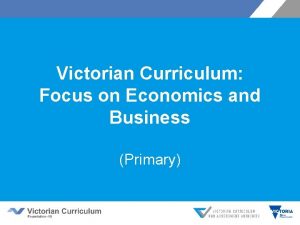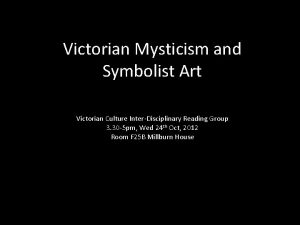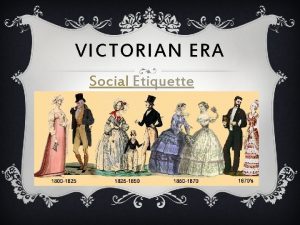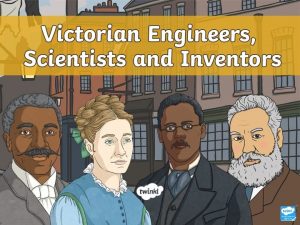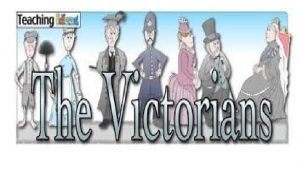Victorian Curriculum Introduction and overview Focus on Design




























- Slides: 28

Victorian Curriculum: Introduction and overview Focus on Design and Technologies

Why curriculum matters q The curriculum is a statement of the purpose of schooling. q It is a public commitment to the learning valued by the community q It defines what it is that all students have the opportunity to learn as a result of their schooling, set out as a series of learning progressions (according to Marzano, the provision of a ‘guaranteed and viable curriculum’ is one of the factors that has most impact on student learning). q Enabling and monitoring every students’ progress along these learning continua is the fundamental role of teachers and schools and the endpoint and purpose of all reform efforts.

Victorian Curriculum F-10 q The current F-10 curriculum for Victorian schools, Aus. VELS, is based on the Victorian Essential Learning Standards (VELS). The content of the English, Mathematics, Science, History and Geography curricula were adjusted in 2013 to incorporate the development of the Australian Curriculum in these areas. q Work has since been undertaken in all other learning areas to incorporate the full Australian Curriculum. The English, Mathematics, Science, History and Geography curricula have also been revised following the review of the Australian Curriculum in 2014.

Victorian Curriculum F-10 q This final version is titled the Victorian Curriculum F 10 q The Victorian Curriculum now provides a stable foundation for whole schooling curriculum and assessment planning q The Victorian Curriculum incorporates the Australian Curriculum and reflects Victorian standards and priorities.

Victorian Curriculum F-10 – by 2017 Learning Areas Capabilities • • • The Arts o Dance o Drama o Media Arts o Music o Visual Communication Design (7 -10) o Visual Arts English Humanities o Civics and Citizenship o Economics and Business o Geography o History Languages Health and Physical Education Mathematics Science Technology o Design and Technologies o Digital Technologies Critical and creative thinking Intercultural Ethical Personal and social

Timelines Implementation of the new Victorian Curriculum can commence in individual schools as soon as they choose, with all schools required to implement the new curriculum from the start of 2017. In other words, schools will have the remainder of 2015 and all of 2016 to prepare for full implementation in 2017. 2015 -16 • • Aus. VELS curriculum • available Aus. VELS website • archived December 2016 From 2015 Victorian Curriculum available Full implementation from 2017

Locating information Curriculum Resources and Support

Terminology Aus. VELS - VELS component Victorian Curriculum Domains Curriculum areas Dimensions Strands and sub-strands ------- Content descriptions Learning focus ------- Standards Achievement standards

Components Introduction Curriculum Rationale and aims Level / band description Structure - strands / sub-strands - placement of standards Learning in. . Content descriptions (+ elaborations ) Scope and sequence Glossary Achievement standards

Structure of VC: D&T Content Descriptions Specifies the knowledge, understandings and skills students are expected to learn. Content Elaborations • Illustrations or examples of Content Descriptions. Achievement Standards Describe what students are typically able to understand able to do. They describe expected achievement and emphasise the depth of conceptual understanding and the sophistication of skills. Examples

What is Design and Technologies? One learning area Technologies Two domains (curriculum areas) Three strands in Design and Technologies and Society Technologies Contexts Digital Technologies Creating Designed Solutions

Creating Designed Solutions Technologies and Society Focuses on how people use and develop technologies Based on design thinking, design processes and production processes’ typically addressed through a design brief Design and Technologies involves students creating quality designed solutions across a range of technologies contexts Technologies Contexts Focuses on the characteristics and properties of four technologies contexts

Creating quality designed solutions across a range of technologies contexts Considering the economic, environmental and social impacts of technological change and how the choice and use of technologies may contribute to a sustainable future What does Design and Technologies involve? Taking into account the ethical, legal, aesthetic and functional factors that inform the design processes

Organisation of the VC: D&T

Creating Designed Solutions Investigating involves critiquing, explore and investigating needs and opportunities Generating developing and communicating ideas for a range of audiences Producing applying a variety of skills and techniques to make designed solutions to meet specific purposes and user needs Evaluating evaluating and making judgements through a design process about the quality and effectiveness of their designed solutions and others Planning and managing learning to plan and manage time, along with other resources, to effectively create design solutions


Systems thinking Design thinking Generation of ideas and decisions made throughout the design processes; recognition of the connectedness and interactions Use of strategies for understanding design needs and opportunities Focus on different types of thinking Computational thinking Problem-solving used e. g. calculating costs, testing materials

Design and Technologies Contexts Engineering principles and systems explores how forces can be used to create light, sound, heat, movement, control or support in systems Food and fibre production focuses on food and fibre as humanproduced or harvested resources, and how food and fibre are produced in managed environments such as farms or plantations, or harvested from wild stocks. Food specialisations explores the application of nutrition principles and the characteristics and properties of food, food selection and preparation, and contemporary food issues Materials and technologies explores a broad range of traditional, contemporary and emerging materials that involve an extensive use of technologies.

Engineering principles and systems § explores how forces can be used to create light, sound, heat, movement, control or support in systems § students develop an understanding of how forces and the properties of materials affect the behaviour and performance of designed engineering solutions

Food and fibre production § focuses on food and fibre as human-produced or harvested resources, and how food and fibre are produced in managed environments such as farms or plantations, or harvested from wild stocks. § develop an understanding of the challenges involved in managing these resources within sustainable agricultural systems. § develop their knowledge and understanding about the managed systems that produce food and fibre through creating designed solutions.

Food specialisations § explores the application of nutrition principles and the characteristics and properties of food, food selection and preparation, and contemporary food issues. § come to understand the importance of a variety of foods, sound nutrition principles, food preparation skills and food safety

Materials and technologies § explores a broad range of traditional, contemporary and emerging materials, and specialist areas that involve an extensive use of technologies. § students learn to make ethical and sustainable decisions about designed solutions and processes by learning about and working with materials and production processes.

Structure of VC: D&T Band Descriptions Provides an overview to the content descriptions and achievement standard within the band Content Descriptions Specifies the knowledge, understandings and skills students are expected to learn. Content Elaborations • Illustrations or examples of Content Descriptions (not mandated). Achievement Standards Describe what students are typically able to understand able to do. They describe expected achievement and emphasise the depth of conceptual understanding and the sophistication of skills. Victorian Curriculum : Design and Technologies curriculum

Focus on sustainability

Sustainability easily explained https: //www. youtube. com/watch? v=_5 r 4 lo. XPyx 8

Design awareness in schools qwww. vcaa. vic. edu. au/Pages/foundation 10/curriculum/resources/designawaren ess/index. aspx

Activity Select one or more D&T contexts and list ideas for designed solutions that could be created for a specified band. • For each designed solution, identify • which context/s are being addressed • what skills are being developed and which band are they appropriate for • what sustainability issues being addressed • what modifications, if any, could be made to the design brief.

Contact Details Victorian Curriculum and Assessment Authority (VCAA) Leanne Compton Curriculum Manager, Design and Technologies compton. leanne. l@edumail. vic. gov. au phone: (03) 9032 1698
 Greek era floral design
Greek era floral design French rococo floral design
French rococo floral design Victorian curriculum progression points
Victorian curriculum progression points Porter's competitive strategies
Porter's competitive strategies Differentiation business level strategy
Differentiation business level strategy Hpe vic curriculum
Hpe vic curriculum Victorian curriculum health and physical education
Victorian curriculum health and physical education Victorian curriculum visual arts scope and sequence
Victorian curriculum visual arts scope and sequence Victorian curriculum economics
Victorian curriculum economics Critical and creative thinking vic curriculum
Critical and creative thinking vic curriculum Victorian curriculum history scope and sequence
Victorian curriculum history scope and sequence Victorian curriculum science scope and sequence
Victorian curriculum science scope and sequence Victorian curriculum economics and business
Victorian curriculum economics and business Language
Language Actor focus vs object focus
Actor focus vs object focus Victorian history curriculum
Victorian history curriculum Victorian curriculum achievement standards
Victorian curriculum achievement standards Eal curriculum scope and sequence
Eal curriculum scope and sequence Progression points victorian curriculum english
Progression points victorian curriculum english Victorian curriculum f 10
Victorian curriculum f 10 Victorian curriculum economics
Victorian curriculum economics Different types of dinosaurs
Different types of dinosaurs Victorian curriculum japanese
Victorian curriculum japanese Dance curriculum victoria
Dance curriculum victoria Victorian curriculum technology
Victorian curriculum technology Victorian curriculum eal
Victorian curriculum eal Victorian curriculum intercultural capability
Victorian curriculum intercultural capability Eal victorian curriculum
Eal victorian curriculum Victorian curriculum dance
Victorian curriculum dance


